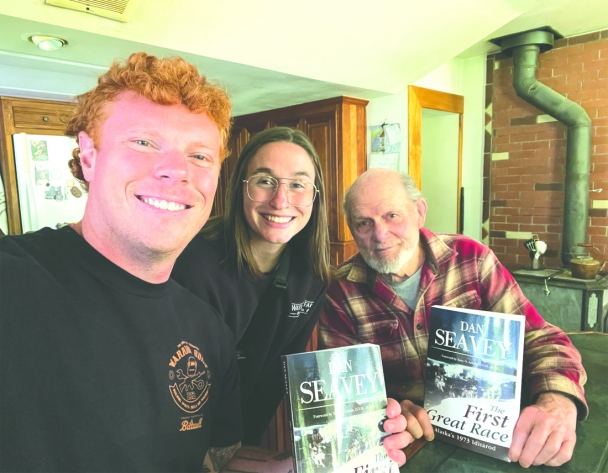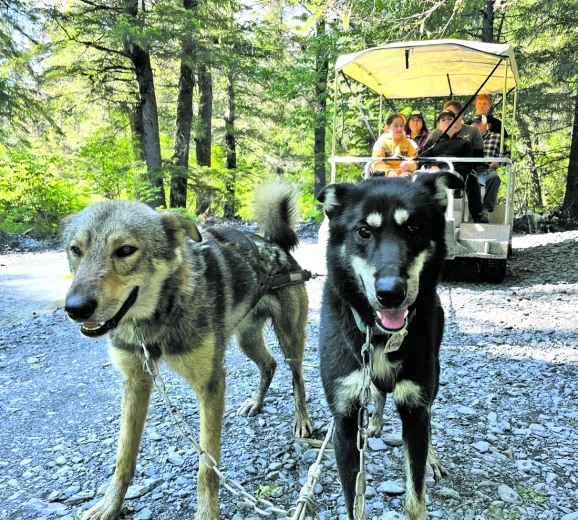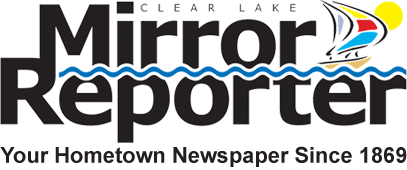Clear Lake woman has ties to Iditarod winner

Scott and Lauren Watson pose for a picture with Lauren’s great-uncle, Dan Seavey, at his home in Seward, Alaska. Seavey wrote a book entitled, “The First Great Race,” which commemorates his participation in the 1973 Iditarod. Seavey is the grandfather of current Iditarod winner, Dallas Seavey. -Submitted photo

Scott and Lauren Watson enjoyed a cart ride pulled by sled dogs while they visited Alaska. The Seavey family owns a business called, IdidaRide Seavey Family Sled Dog Tours, that welcomes visitors to learn about and experience sled dog racing. -Submitted photo
Here in Iowa we may complain about snow and adverse weather conditions, but for those who compete in Alaska’s great dog sled race, the Iditarod, we endure nothing compared to them.
The 2024 Iditarod covered approximately 975 miles through some of Alaska’s most wild and unpredictable terrain. It is an exhilarating experience for mushers (sled drivers), sled dogs and spectators alike. The race began on Saturday, March 2, with a ceremonial start in Anchorage. The race officially began on Sunday, March 3, in Willow and traveled all the way to the city of Nome. This year, 40 dog teams competed on the historic trail.
The Iditarod has been a part of Lauren Watson’s life since she was a little girl when she’d go to Alaska to visit her great-uncle, Dan Seavey and his wife, Shirley, and their three children, Darian, Mitch and Tracie, in Seward, Alaska.
“Uncle Danny was the closest thing I had to a grandparent on my Mom’s side,” said Lauren, who is now from Clear Lake. “My uncle had moved to Alaska from Minnesota in 1963 to be a teacher, fell in love with the place and decided to stay.”
Being a history teacher, Dan Seavey had a love for everything Alaskan, especially its rich history. In 1925, The Great Race of Mercy gained notoriety as dog sled teams delivered medicine during the Nome diphtheria epidemic. Twenty mushers and 150 sled dogs endured temperatures around -80 degrees F, in unstable conditions, to get the medicine to treat 10,000 sick children. The events of that run is what solidified dog sledding in Alaska and peaked Seavey’s interest.
By the mid 1960’s, the use of sled dogs was almost non-existent. In 1973 a board was formed to revive dog sled racing and Dan Seavey was on that board.
Dan started a kennel in 1966 with his first litter of huskie puppies and in 1970 he had his first sled team. He raced in the first two Iditarods, in 1973 and 1974. His final race was in 2012 at the age of 74. Dan is in the Iditarod Hall of Fame and is known as a patriarch, pioneer and preservationist of the great race.
Dan’s son, Mitch Seavey, who is now retired, also had a lot of success, winning three Iditarod races. Racing and a love of dogs is in the Seavey blood, with Mitch’s son, Dallas, taking over the reigns.
Dallas Seavey is the winner of the 2024 Iditarod, making it his sixth championship. This win has made Dallas the most celebrated musher in the 52 years of the race. Dallas completed the race in nine days, two hours, 16 minutes and eight seconds. Dallas has completed the Iditarod 13 times and has finished in the Top Ten 11 times. In 2012, he became the youngest musher to win the Iditarod at the age of 25. Now at the age of 37, he has the most wins of any musher to compete in the race.
“I think it’s pretty cool that most people who have any tie to Alaska know of sled dog racing and if they do, they have probably heard of my family’s name,” said Lauren.
Lauren and her husband, Scott, honeymooned in Alaska last summer. While they were there, they spent some time at Lauren’s Uncle Dan’s home and kennel in Seward. The Seavey family own and operate IdidaRide Seavey Family Sled Dog Tours, which allows the public to experience and learn about sled dog racing. Mitch Seavey owns a branch of the business in Sterling, Alaska. While visiting, Scott and Lauren went on a cart ride that was pulled by sled dogs. Guides gave history lessons and visitors had the chance to take pictures with puppies and interact with the dogs. A more advanced IdidaRide tour includes a helicopter ride to a glacier and a chance to see the sled dogs in action training in the snow.
“It’s interesting to see all the age groups of dogs, some are in training to be racers,” said Lauren. “They pick the strongest dogs to be on the sled and they know each dog’s personality and which ones work well together. It’s a real methodical process.”
Sled dogs have a unique genetic makeup that allows them to cross vast distances with incredible endurance. Only northern dog breeds are allowed to compete. The dogs live on a diet of rich proteins and healthy fats, sled dogs are able to regulate body heat to levels other dogs cannot. Additionally, they have unique coats, bone structure and even blood vessels that help them endure the exertion and extreme cold. They are not only strong, but fast, they can run anywhere from 10-20 mph, which they can sustain for 100 miles without rest.
Lauren said she and Scott will be making many more trips to Alaska over the years. “We love Alaska and being from Minnesota I can say that northern Minnesota is like a junior Alaska, but without the mountains. “There is nothing like the vastness and beauty of Alaska.”
Category:
Clear Lake Mirror Reporter
12 N. 4th St.
Clear Lake, IA 50428
Telephone: +1 (641) 357-2131
Submissions
Mid-America Publishing
This newspaper is part of the Mid-America Publishing Family. Please visit www.midampublishing.com for more information.
